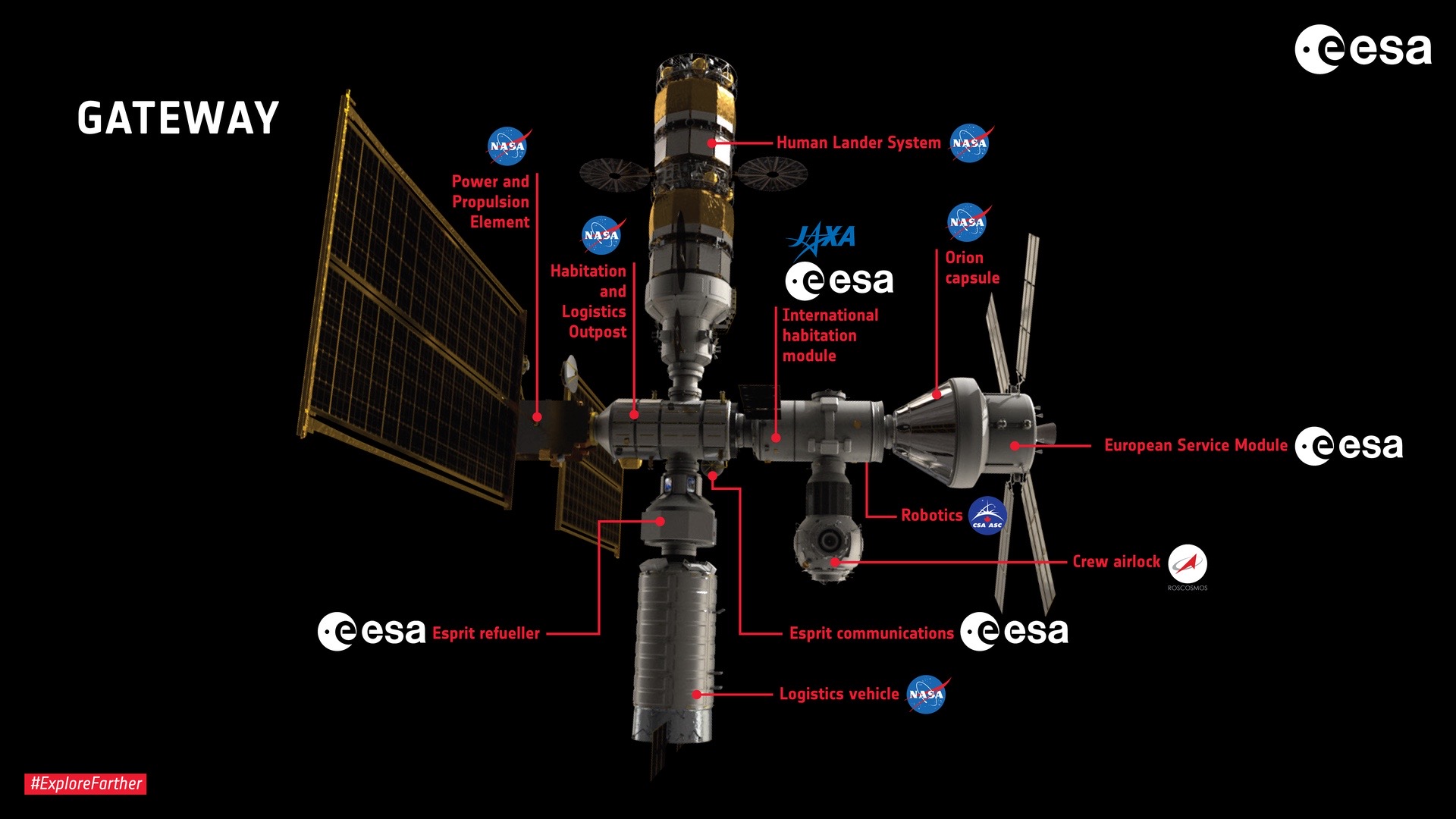Europe will help build NASA's moon-orbiting Gateway space station

NASA's moon-orbiting space station just got a new high-profile partner.
The European Space Agency (ESA) signed a memorandum of understanding (MoU) on Tuesday (Oct. 27) formalizing its collaboration on Gateway, a planned outpost in lunar orbit that NASA sees as key to its Artemis program of crewed moon exploration.
Under this new agreement, ESA will provide Gateway with a habitation module and a refueling module, both of which the European agency will operate once the hardware is up and running. ESA contributions will also include two additional service modules for NASA's Orion capsule, the spacecraft that will launch Artemis astronauts from Earth atop the agency's Space Launch System (SLS) rockets.
Moon master: An easy quiz for lunatics
In return, ESA will get three flight opportunities for European astronauts to launch to and work aboard Gateway.
"This partnership leverages the outstanding cooperation established by the International Space Station as we push forward to the moon," NASA Administrator Jim Bridenstine said in a statement today. "Gateway will continue to expand NASA's cooperation with international partners like ESA, ensuring the Artemis program results in the safe and sustainable exploration of the moon after the initial human lunar landing and beyond."
That initial crewed landing is scheduled to take place in 2024, near the lunar south pole. Gateway will likely not be involved in that epic touchdown, but NASA envisions the orbital outpost playing a large role in Artemis' longer-term goal of establishing a sustainable human presence on and around the lunar surface.
Breaking space news, the latest updates on rocket launches, skywatching events and more!
Gateway, which will be about one-sixth the size of the International Space Station, will serve as a staging ground and jumping-off point for trips to the moon's surface, for both crewed and uncrewed missions, NASA officials have said.
"The Gateway is designed to be supplemented by additional capabilities provided by our international partners to support sustainable exploration," Kathy Lueders, NASA associate administrator for the Human Exploration and Operations Mission Directorate at NASA headquarters, said in the same statement. "Gateway is going to give us access to explore more of the lunar surface than ever before, and we're pleased that partners like ESA will join us on these groundbreaking efforts."
The first two pieces of Gateway, the Power and Propulsion Element (PPE) and the Habitation and Logistics Outpost (HALO), are scheduled to launch together in November 2023. These elements will be built by American companies, with Maxar Technologies providing the PPE and Northrop Grumman constructing HALO.
The European habitat module, known as I-Hab, will do more than simply augment HALO; I-Hab will be "the main habitat for astronauts when they visit the Gateway," ESA officials said in a statement today. I-Hab will incorporate contributions from the Japan Aerospace Exploration Agency, and it will feature two docking ports for crewed human landers, NASA officials said.
Those human landers will be built by one or more American companies. Earlier this year, NASA awarded contracts to three private groups — Dynetics, SpaceX and The National Team, led by Jeff Bezos' Blue Origin — to develop crewed lander concepts. The agency is expected to select one or more of these ideas for further development in early 2021.
The ESA-provided refueling module, called Esprit, will sport a large window similar to the European-built Cupola on the International Space Station, ESA officials said. In addition to its refueling role, Esprit will enhance Gateway's communications capabilities.
"This MoU marks a critical point in Europe's trajectory: It confirms we are going forward to the moon, not just in terms of equipment and technology, but also with our people," ESA Director General Jan Wörner said in the ESA statement.
"Europe will play a central role in the new era of global space exploration along with NASA and our partners, delivering exemplary, game-changing architectures to explore the moon and Mars and inspiring generations to come," Wörner said.
The newly announced MoU further adds to Artemis' international feel. Earlier this month, for example, NASA revealed that eight nations have signed the Artemis Accords, a set of principles outlining the responsible exploration of the moon, clearing the way for these countries to participate in the Artemis program.
Editor's note: The original version of this story stated that the PPE and HALO will launch together on an SLS rocket. That's not the case; a commercial provider is expected to be tapped for the launch.
Mike Wall is the author of "Out There" (Grand Central Publishing, 2018; illustrated by Karl Tate), a book about the search for alien life. Follow him on Twitter @michaeldwall. Follow us on Twitter @Spacedotcom or Facebook.

Michael Wall is a Senior Space Writer with Space.com and joined the team in 2010. He primarily covers exoplanets, spaceflight and military space, but has been known to dabble in the space art beat. His book about the search for alien life, "Out There," was published on Nov. 13, 2018. Before becoming a science writer, Michael worked as a herpetologist and wildlife biologist. He has a Ph.D. in evolutionary biology from the University of Sydney, Australia, a bachelor's degree from the University of Arizona, and a graduate certificate in science writing from the University of California, Santa Cruz. To find out what his latest project is, you can follow Michael on Twitter.

